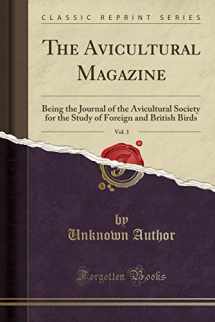
The Avicultural Magazine, Vol. 3: Being the Journal of the Avicultural Society for the Study of Foreign and British Birds (Classic Reprint)
ISBN-13:
9781332103096
ISBN-10:
133210309X
Author:
Publication date:
2018
Publisher:
Forgotten Books
Format:
Paperback
244 pages
FREE US shipping
Book details
ISBN-13:
9781332103096
ISBN-10:
133210309X
Author:
Publication date:
2018
Publisher:
Forgotten Books
Format:
Paperback
244 pages
Summary
The Avicultural Magazine, Vol. 3: Being the Journal of the Avicultural Society for the Study of Foreign and British Birds (Classic Reprint) (ISBN-13: 9781332103096 and ISBN-10: 133210309X), written by authors
, was published by Forgotten Books in 2018.
With an overall rating of 3.5 stars, it's a notable title among other
books. You can easily purchase or rent The Avicultural Magazine, Vol. 3: Being the Journal of the Avicultural Society for the Study of Foreign and British Birds (Classic Reprint) (Paperback) from BooksRun,
along with many other new and used
books
and textbooks.
And, if you're looking to sell your copy, our current buyback offer is $0.43.
Description
Excerpt from The Avicultural Magazine, Vol. 3: Being the Journal of the Avicultural Society for the Study of Foreign and British BirdsImmature males, and males which have been kept in cages, resemble the females, but the golden of the head and rump is less orange in immature birds.Scientific ornithologists have introduced this species into the British list on the ground that five examples have been obtained, within a period extending over something like twenty-three years, at sea-ports or within easy reach of the sea. When it is remembered that the Pine Grosbeak is a common cage-bird in Canada; and sufficiently pleasing, when in full colour, to be attractive to sailors; although less likely to satisfy them when (owing to close confinement) the glory has departed from the plumage; the only wonder is that at least fifty have not fallen to that impulse said to be natural to true-born Britons in fine weather - "Lovely day! Let's go and kill something."The nest of the Pine Grosbeak is usually placed on a thick branch of spruce-fir, or birch, close to the main stem and at a distance of from ten to twelve feet from the ground; it is somewhat like a large edition of that of the Bullfinch, the outer framework consisting of slender twigs of fir and the inside of fine grass-bents, roots, and hair-lichen. The eggs number from three to four, of a pale turquoise blue colour, with deep purplish-brown or blackish spots, and greyer brown shell-spots ; they vary much in the same manner as eggs of the Bullfinch.During the winter months this species is gregarious in its habits, and is so tame that it is easily caught or shot, but in the summer the flocks break up for breeding purposes and the birds are then somewhat more shy, though never so much so as our Bullfinch.About the PublisherForgotten Books publishes hundreds of thousands of rare and classic books. Find more at www.forgottenbooks.comThis book is a reproduction of an important historical work. Forgotten Books uses state-of-the-art technology to digitally reconstruct the work, preserving the original format whilst repairing imperfections present in the aged copy. In rare cases, an imperfection in the original, such as a blemish or missing page, may be replicated in our edition. We do, however, repair the vast majority of imperfections successfully; any imperfections that remain are intentionally left to preserve the state of such historical works.


We would LOVE it if you could help us and other readers by reviewing the book
Book review

Congratulations! We have received your book review.
{user}
{createdAt}
by {truncated_author}


